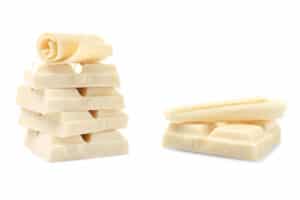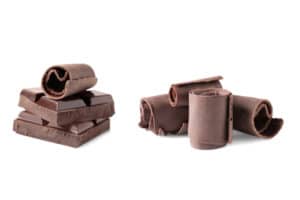Chocolate (n.) — a delightful treat for paydays, anniversaries, binge-watching, dreaded Mondays, boring dates, exhausting weeks, nagging boss, spy missions, and broken hearts.
Chocolate has been a gastronomic companion in the highs and lows of our lives. From the luscious deep brown color to the fascinating multi-layered aroma of butter and cocoa, to the dairy, milky, creamy bittersweet goodness that melts in our mouth, eating chocolate is such a rich sensory experience. It is no wonder how we crave chocolates when we’re happy, sad, angry, or bored.
Chocolate goes well with other delicious treats, too — coffee, fruits, nuts, cheese, salty snacks, wine, chili, the list goes on. Whether you’re a chocoholic or a chocolatier, this precious confection is an addiction that we probably will never get out of. To some countries like Belgium, Mexico, France, Germany, and Switzerland, chocolate is a national treasure. But to the rest of the world, it is a global phenomenon that will always have a space in our candy jars and fridge.
But chocolates are not all created equal — at least not in the amount of cocoa, milk, sugar, and cocoa butter in them. In this article, we will explore the different types of chocolate and the best ways to consume them, plus other bites of chocolatey trivia!
Where did chocolate originate?
The term “chocolate” came from the Aztec word, “xocoatl,” which means a bitter drink made from cacao beans. Theobroma cacao, which is the Latin term for cacao, literally means “food of the gods.” Whether the gods drink or eat chocolates, we’ll probably never know. What we know is that the world’s chocolate obsession began when the Olmecs first drank chocolate in Mesoamerica (present-day Mexico) 4,000 years ago.
Centuries later, drinking chocolate became a sacred part of the Mayan and Aztec cultures. They believed that the cacao bean had magical and divine elements suitable for birth, marriage, and even death. By the 16th century, chocolate reached Spain through Spanish explorers who journeyed to America.
Then the Europeans invaded the Americas. The foreign conquerors initially referred to chocolate as a “bitter drink for pigs.” After mixing in sugar and honey, however, chocolate became a fashionable beverage across Europe by the 17th century.
But it wasn’t until 1827 that cocoa powder was discovered. A Dutch chemist successfully made powdered chocolate by removing half of the cacao butter from the chocolate liquor and pulverizing whatever properties remained. He also added alkaline salts to lessen the bitter taste. This product is what we now know as “Dutched cocoa.”
Two decades later, the first modern chocolate bar was created by Joseph Fry. The English chocolate maker added melted cacao butter to Dutched cocoa to make moldable chocolate paste. By 1868, Cadbury began selling chocolate candies in England.
What are the main components of chocolate?
After 4,000 years of chocolate making, different varieties of chocolates have been created. To understand the different types of chocolate, we need to first be familiar with its basic chemistry.
In making chocolates, less is more. Chocolate usually has 4 ingredients: chocolate liquor made from cacao beans, cocoa butter, sugar, and milk.
Cacao beans
Without cacao, it’s hard to identify something as chocolate. The cacao bean refers to the seed of the cacao plant. These seeds are scooped out from the cacao pods and are processed into cacao nibs (crushed de-shelled cacao beans).
Chocolate liquor
Chocolate liquor, the American term for “cocoa mass,” contains 52-54% cocoa butter and 46-48% cocoa solids (cocoa powder). It is a dark brown and thick paste prepared from cacao nibs.
To make chocolate liquor, the cacao beans are fermented, dried, and roasted. The beans are then deshelled and crushed to make cacao nibs. The nibs are ground into a fine texture of cocoa mass. The mass is then melted into liquid, which has roughly equal proportions of cocoa solids and cocoa butter. According to FDA standards, chocolate liquor must not have less than 50% or more than 60% cacao fat.
Despite its name, chocolate liquor doesn’t contain any alcohol. Instead of alcohol, the term liquor is derived from the old word “likur” (modern French, “liqueur“), which means “any matter in a liquid state”.
Other terms for chocolate liquor are cocoa paste, cocoa liquor, bitter chocolate, or simply chocolate.
Cocoa butter
Cocoa butter, also called cacao butter, is the fat produced from cacao beans. When chocolate liquor is pressed and the fatty content is separated, cocoa butter is produced. Unlike the other types of “butter” sold in the market, cocoa butter is not a dairy product.
Cocoa solids
After the chocolate liquor is pressed and the fat is separated, it leaves a dry, dark, bitter component called cocoa solids. Cocoa solids are then finely ground to produce cocoa powder. The resulting cocoa solids vary in their fat content, depending on how much cocoa butter is pressed out. Cocoa powder is said to be the purest form of cocoa solids, with only 10-12% fat content for standard low-fat cocoa powder and 20-24% for high-fat cocoa powder.
What are the main types of chocolates?
There are three formally recognized types of chocolates: white chocolate, dark chocolate, and milk chocolate. Though there are other varieties of chocolates in the market, these three chocolates remain the foundation of chocolate making.
White Chocolate

Good quality white chocolate has a fresh and clean taste that isn’t too sweet. Rather than it being too white, quality white chocolate should have an ivory or pale yellow color akin to cocoa butter. (The whiter the color, the more additives it contains.) And though it lacks cocoa solids, good-quality white chocolate should still have the lingering cocoa flavor and fragrance of cocoa butter. It should also melt easily in your mouth. If it doesn’t, chances are it contains additional oils like vegetable oil.
Among the three chocolates, white chocolate is the sweetest. Its high sugar content and smooth texture make it a great decoration, filling, and ingredient for confectionery, cakes, pastries, and other desserts.
For a better chocolate experience, you can pair white chocolate with caviar, macadamia nuts, blackberries, lemon, matcha, and mocha. Oftentimes, itcan be better alone.
A popular recipe for white chocolate is caramelized white chocolate. To make this, you roast white chocolate slowly and thoroughly until it caramelizes. Caramelized white chocolates that are sold commercially are made of white chocolate mixed with caramel flavors for better consistency, taste, and stability.
Because of its dairy and cocoa butter content, white chocolate has a shorter shelf life than milk and dark chocolate. It can last for up to six months if unopened, and up to four months when opened.
Dark Chocolate

Dark chocolate is only made of two ingredients: sugar and chocolate liquor. Small amounts of soy lecithin or vanilla may be added to enhance the flavor and texture. Some manufacturers also add butterfat, vegetable oils, and artificial flavors, which lowers the quality of dark chocolate.
The amount of cocoa that should be in dark chocolate varies in different regions. In Europe, dark chocolate should contain at least 35% chocolate liquor. In the US, however, the requirement is only at least 15% chocolate liquor. To make high-quality dark chocolate, chocolatiers suggest using 50-90% cocoa solids.
Dark chocolate comes in a variety of cocoa concentrations: sweet dark chocolate, semisweet dark chocolate, and bittersweet dark chocolate.
- Sweet dark chocolate is the mildest form of dark chocolate. In the US, sweet dark chocolate must have a cocoa content of 15-34%.
- Semisweet dark chocolate (or semisweet chocolate) contains 35-49% chocolate liquor. It is often sold as chocolate chips and used in baked goods, such as chocolate chip cookies.
- Bittersweet dark chocolate is the darkest among dark chocolates. It usually has at least 50% cacao content, with some even approaching 100%. Because of its high cocoa percentage, bittersweet chocolate has the most intense chocolate flavor in the chocolate world.
Dark chocolate is popular among bakers because of its chocolate-flavored profile. Bittersweet and semisweet dark chocolates are sometimes used interchangeably in baking.
Dark chocolate is also recognized for its numerous health benefits, such as lower blood pressure and improved blood flow. These benefits make dark chocolate a favorite snack among the health-conscious. Dark chocolate is also great for vegans due to the absence of milk.
When talking about taste, dark chocolate has a creamy and astringent mouthfeel, with intense cocoa, roasted, and fruity aromas. It has lesser sugar content and no dairy ingredients, which give it a firmer and darker texture than white or milk chocolate. It also has different layers of flavors, ranging from sweet, sour, and bitter.
The intense flavor of dark chocolate goes well with bananas, pretzels, potato chips, almonds, peppers, pumpkin, strawberries, and even Parmesan cheese. When stored properly, dark chocolates can last for up to 20 months.
Milk Chocolate

Milk chocolate’s mild yet addictive flavor is a delicate balance of chocolate liquor, milk, and sugar. To meet the standards outlined by the FDA, milk chocolate must contain at least 10% chocolate liquor, 3.39% milk fat, and 12% milk. The only allowed fats are cocoa butter and milk fat.
The presence of milk is what differentiates milk chocolate from dark chocolate. The milk product used in milk chocolates could either be boiled milk, condensed milk, or milk powder. The kind of milk used will affect the caramel flavor in the chocolate. Milk is also responsible for the lighter color of milk chocolate. The milk fat also lowers the melting point of the chocolate, causing it to melt easily in your mouth.
In terms of taste, milk chocolate has a rich dairy, milky, buttery flavor with subtle notes of caramel and vanilla. Compared to dark chocolate, milk chocolate has lower cocoa solids and more sugar content, hence its lighter and sweeter note. Its creamy texture and smooth, velvety taste are the reasons why it’s a popular basis for candy bars and other desserts.
In recent years, chocolatiers have experimented with milk chocolate to amp up its chocolate factor. They started adding higher percentages of cocoa to develop dark milk chocolate, which is chocolatier and less sweet compared to traditional milk chocolate. Some manufacturers would use as high as 56% cocoa in milk chocolate.
You can pair milk chocolate with walnuts, hazelnuts, coconut, orange, apple, peanut butter, caramel, and Asiago cheese. When stored properly, milk chocolate can last up to 16 months.
How do chocolates get their smooth flavor?
If you ever wonder how dark and milk chocolate achieve their smooth texture and velvety taste, it’s due to the process called “conching.”
Conching is usually the final process in making chocolates. The process involves heating and carefully mixing cocoa, cocoa butter, milk (for milk chocolate), any flavor additives, and emulsifiers using a machine called “conche.” Lecithin is the popular choice of emulsifier among major chocolate manufacturing companies. To guarantee the development of rich chocolate flavor, conching may take several hours to several days.
To wrap up
Chocolate is not just candy or dessert. This mouthwatering treat is both a sensory and an emotional experience that brings us to different levels of happiness. Every single bite brings nostalgia. After all, regardless of age, we are all kids at heart.




